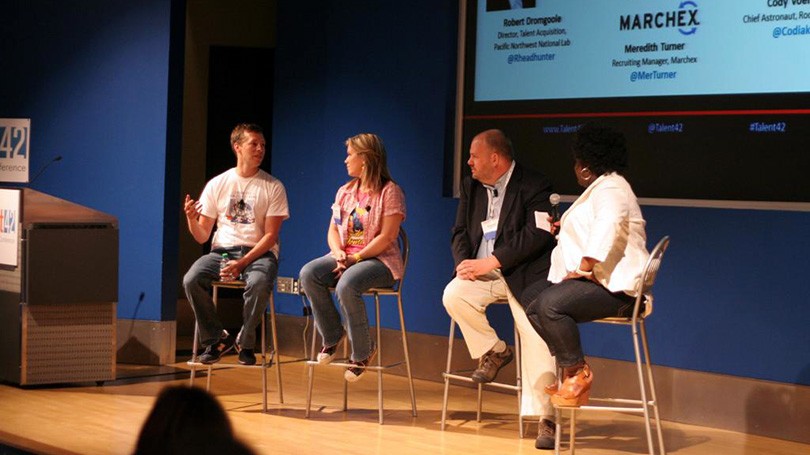3 Big Ideas I heard at the Talent42 Conference
A few weeks back I ventured to my first tech recruiter conference -- Talent42. The host/organizer, John Vlastelica, created an engaging and personal experience where every single recruiter in the audience had the opportunity to voice her ideas, chime in with success stories, or ask the presenters questions. Aside from hearing from an all-star line up of speakers (from Google, Facebook, Dropbox, Square, Microsoft, and so on), the attendees also got to play Recruiter Jeopardy and participate in hands-on sourcing roundtables. All in all, two days very well-spent.
As I walked away from the conference, though, three big ideas stuck with me and I wanted to share them with you:
1. Glen Cathey questioned the usefulness of talent pipelining.
In thought-provoking closing keynote, Glen Cathey, the guru of Boolean search and sourcing, questioned the validity of creating a talent pipeline. According to him, pipelining candidates before you have an open position is equivalent to awaking somebody from hibernation. You have peaked their interest but since you have nothing to offer them, aside from a hypothetical role that may or may not open, they are now more likely to become more proactive and accept an opportunity elsewhere. Instead of pipelining, Cathey suggest that you focus on “just-in-time recruiting.” This means sourcing passive talent only when you have open roles – this way you save both yours and the candidate’s time.
2. Mary Hamershock revealed some of the science behind Google’s job interview process.
In a candid Q&A session, Mary Hamershock, the head of engineer recruiting at Google, revealed a few of the details that go into how Google thinks about job interviews.
According to her, the company strongly believes the hiring decision should never lie with a single person. Instead, the recruiting team at Google strongly abides by James Surowiecki “Wisdom of the Crowds” principle – the idea that a group is empowered to make a better decision than an individual. Hence, there are a few peculiarities in Google’s hiring process:
- Every candidate interviews with exactly four Google employees. According to research that Google conducted with a professor from Stanford, when a candidate interviews with one person there is 51% chance that the right decision will be made at the end. As the number of interviews increases, the odds improve and it turns out that the likelihood of making the best decision peaks at four interviews.
- As Google was infamous for its difficult brainteasers and strong preference for impressive school pedigrees and GPAs, the company took time to study the effectiveness of these requirements. It turned out that there was no correlation between how candidates performed in their roles in the company and how they did answering the brainteasers or what was their GPA (except for new grads). Instead, Google now relies heavily on structured interviewing which has proven to be way better at predicting the candidate’s success.
3. It’s not about identifying talent — it’s about converting it.
The recurring observation that recruiters voiced was that when it comes to tech talent, most companies have a very clear idea of exactly how many engineers are out there (500,000 in North America, according to Google’s team) and who they are. Finding them is not the challenge. Taking the right steps to convert them is. After all, in an industry where elaborate perks are a given, you have to be quite creative to stand out. Here are a few ideas that presenters shared:
- Know who is your competition and explain how you are different: If you are a start-up, you are not competing with Google and other tech giants. You are competing with other start-ups, so make sure you can articulate how you are different from them and what makes you an exciting company to work for. [advice from Elaine Wherry, Meebo)
- It’s about your company’s mission: The team at Square shared that as they are growing more and more and cannot use the start-up card, they are relying on mission-oriented recruiting. According to them, rallying tech talent behind an exciting and disruptive goal can be a powerful motivator to join a company.
- It’s not about you, it’s about them: A lot of recruiters make the mistake of starting a conversation with a candidate and talking only about themselves and the company they are representing. Instead, think about how the opportunity you are offering can further the candidate’s career path and goals. Make sure you align the candidate’s ambitions with the problem you are offering them to solve, advised Rob Dromgoole from Pacific Northwest National Laboratory.
- Make your candidate experience truly personal: A good way to win over candidates is to invite them to hang out with the team they would potentially join. Let them chat with the teammates, learn more about their background, and experience the day-to-day atmosphere in the office. Another gesture that can differentiate you is going the extra mile and sending flowers to the interviewee’s significant other – while it sounds a tad creepy, recruiters vouched that it works. (advice from Meredith Turner — Marchex)
These are a few of the idea that stood out for me. If you are curious for more, you can find all the conference presentation decks on SlideShare. Do you think there are any other big ideas that are shaping tech recruiting nowadays? Let us know at @HireOnLinkedIn.
Check out the Talent42 website for more info about the conference or about attending in June 2015.
* image by Cody Voellinger
Topics: Candidate experience
Related articles




